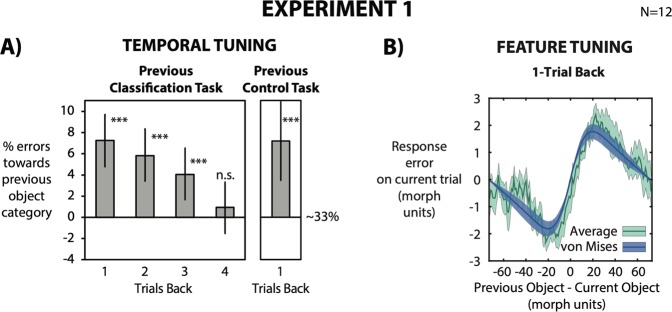Figure 3.
(A) We computed the percentage of errors towards the object category in the previous trial, normalized for the 33% chance level (chance baseline was confirmed by permuted null distribution). A 0% value indicates no bias from the previous object category, with a 33% chance of classifying the object as A/B/C. Higher and lower values than 0% indicate that a classification response was biased towards the previous object category (higher than 33%) or biased away (lower than 33%), respectively. For each observer we obtained a mean bootstrapped percentage by resampling the data with replacement 5000 times. Error bars are bootstrapped 95% confidence intervals, and p-value is based on the group bootstrapped distribution. Observers’ responses were strongly biased towards the previous object category up to 3 trials back (12 seconds back in time). Similar results were found when observers were asked to simply press the response bar in the 1-back trial, indicating that our results are not due to a response bias. (B) Response errors were computed as the distance between the response (corresponding to prototypes 1-A, 50-B or 99-C ) and current morph. Error plot as a function of the relative morph difference of the previous trial (1-back). The x-axis represents the difference between the previous and current object in morph units. The y-axis represents the error in the classification task (difference between response and object morph on current trial). The average error (green line) shows more negative response errors for a negative relative morph difference and more positive errors for a positive relative morph difference. Green shaded error bars indicate standard error across observers. The dark blue line indicates the average von Mises distribution across observers. Green shaded error bars indicate standard error across observers. Morph classification was attracted toward the morph seen on the previous trial. Importantly, it was tuned for similarity between previous and current morph (feature tuning).

